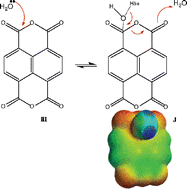Mechanism of 1,4,5,8-naphthalene tetracarboxylic acid dianhydride hydrolysis and formation in aqueous solution
Abstract
The study of highly conjugated,

* Corresponding authors
a Universidade Paulista, Instituto de Ciências da Saúde, Bauru, SP, Brazil
b Departamento de Química Fundamental and Instituto de Química da, Universidade de São Paulo, SP, Brazil
c
Departamento de Bioquímica do, Instituto de Química da, Universidade de São Paulo, SP, Brazil
E-mail:
imcuccov@quim.iq.usp.br
The study of highly conjugated,

 Please wait while we load your content...
Something went wrong. Try again?
Please wait while we load your content...
Something went wrong. Try again?
T. C. Barros, I. M. Cuccovia, J. P. S. Farah, J. C. Masini, H. Chaimovich and M. J. Politi, Org. Biomol. Chem., 2006, 4, 71 DOI: 10.1039/B512187F
To request permission to reproduce material from this article, please go to the Copyright Clearance Center request page.
If you are an author contributing to an RSC publication, you do not need to request permission provided correct acknowledgement is given.
If you are the author of this article, you do not need to request permission to reproduce figures and diagrams provided correct acknowledgement is given. If you want to reproduce the whole article in a third-party publication (excluding your thesis/dissertation for which permission is not required) please go to the Copyright Clearance Center request page.
Read more about how to correctly acknowledge RSC content.
 Fetching data from CrossRef.
Fetching data from CrossRef.
This may take some time to load.
Loading related content
